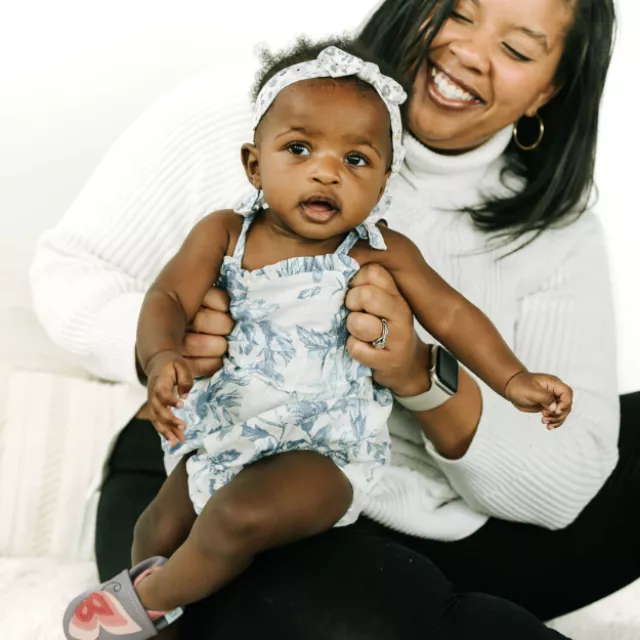When do babies start to crawl, cruise and walk?
Your little one is happily lying on a playmat at playgroup and the baby next to them is rolling around or sitting up. It can be so easy to compare and worry about milestones. It is always best to talk to your health visitor or other healthcare provider if you are worried. One of the best things I read was “Popcorn is prepared in the same pot, at the same heat, in the same oil and yet…the kernels do no pop at the same time. Don’t compare your baby to others. Their time to pop is coming.”
Babies developmental milestones vary from child to child but they do typically occur within a certain age range so here is a general timeline.
- Crawling: Crawling is usually the first mode of independent mobility for babies, and it typically occurs between 6 to 10 months of age. Some babies may start crawling earlier, around 6 months, while others may start a little later, around 9-10 months. Crawling doesn't have to be on all fours in the traditional way we think of it. Crawling involves using the arms and legs to move around on the stomach or hands and knees. It can include commando crawling, crab crawling and bum shuffling. If you want lots of information on types of crawling and how to encourage your baby to crawl then head to pampers.co.uk who have a whole range of interesting articles on it.
- Cruising: Cruising is the stage where babies use furniture or other objects to support themselves while moving around. It usually happens after crawling and typically occurs around 9 to 12 months of age. During cruising, babies pull themselves up to a standing position using furniture or other stable objects and then move along while holding onto them for support. Just like crawling, cruising gives your baby access to lots more dangers and so making sure the area is safe is important. There are lots of tips on baby proofing your house. If you would like information on cruising then head to mybabymanual.co.uk who have a useful page full of information and tips.
- Walking: Walking is the stage where babies are able to take independent steps without any support. It typically occurs between 9 to 15 months of age, although some babies may start walking as early as 9 months or as late as 15 months or even later. Walking involves balancing on two feet and taking steps with alternating leg movements. Those first few wobbly steps are a much anticipated milestone with those first independent steps signalling a move to toddlerhood. You may notice your baby practicing to stand up and balance before they brave those first few steps. Walking is a journey that starts long before those first wide footed steps, if you would like more information on route to walking and beyond then have a read at babycentre.co.uk.
This is just a rough guide and as we said at the start every baby is different with a wide range of normal development. Temperament, environment and even their size can impact on when they start to walk. Some babies may reach these milestones earlier or later than the typical timeline, and that's perfectly normal. It's important to encourage your baby's development by providing opportunities for them to explore and move, but also to be patient and supportive as they progress through these stages at their own pace. If you have concerns about your baby's motor development, it's always best to consult with your health visitor or paediatrician for guidance and reassurance.
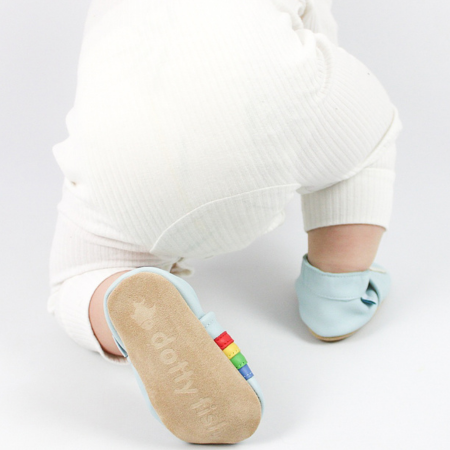
Crawling Shoes?
Babies do not necessarily need shoes when they start crawling. In general, it is recommended to allow babies to crawl barefoot as much as possible as this allows babies to have direct contact with the ground, which helps them develop their balance, coordination, and sensory awareness. Crawling barefoot also allows your baby's feet to develop naturally and promotes proper foot development.
However, there may be situations where being barefoot isn't practical, such as protecting their feet from sharp objects or rough surfaces. If you do decide to use shoes while your baby is crawling, it's important to choose shoes that are soft, flexible, and breathable. Look for shoes made from materials such as soft leather or mesh, with a flexible sole that allows the baby's feet to move naturally.
It's also essential to ensure that the shoes fit properly and do not hinder the baby's movements or compress their feet. Shoes that are too tight or have stiff soles can restrict the baby's foot movements and impede their natural development. It's recommended to measure your baby's feet regularly and choose shoes that are appropriate for their age, size, and developmental stage. All Dotty Fish shoes include a 1cm wriggle room in the wide toe area so that little toes can stretch and flex as nature intended. All our soft sole baby shoesare an ideal choice for protecting little feet while crawling. Our shoes have been tested by podiatrists to make sure they are designed to be the next best thing to bare feet.
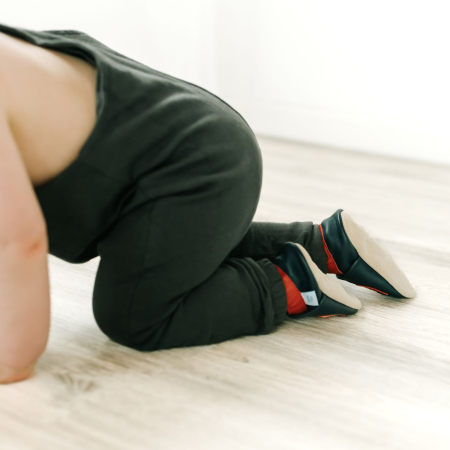
Cruising Shoes?
Again babies don't necessarily need specific "cruising shoes" as they begin to cruise or take their first steps. During this stage, babies are still learning to balance and coordinate their movements, and they usually rely on their hands and arms to hold onto furniture for support. As with crawling barefoot is still best at this stage as it allows their feet to develop naturally and promotes proper foot development. Being able to feel the floor will help with their balance, coordination, and sensory awareness. Socks at this stage can lead to sliding feet which isn't ideal and they just never seem to stay on. A simple soft sole baby shoe is often a great choice during this stage and can be the same shoes you used while they are crawling. There is no need to buy a specific 'cruiser'. As with crawling shoes they need to be soft, flexible, and provide a good grip. A lightweight, flexible sole that allows the baby's feet to move naturally is vital. Avoid hard soled shoes or shoes that are too stiff as these restrict your baby's foot development.
All our soft sole shoes and per-walker shoes have been designed with growing little feet in mind and have been podiatry tested and approved. They mimic the feeling of being barefoot while giving protection and a little bit of extra grip on hard surfaces. These types of shoes provide minimal support and allow the baby's feet to move naturally. However, keep in mind that it's still beneficial for babies to spend plenty of time barefoot to allow their feet to develop properly.
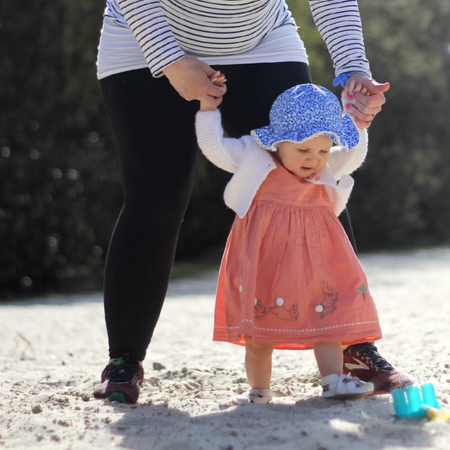
First Walking Shoes?
While your baby is learning to walk it is still important to keep their feet barefoot as much as possible. The same soft sole shoes for crawling and cruising may still be worn to add grip and keep babies feet from getting cold. While indoors being barefoot is especially recommended during the early stages of walking. This again allows their feet to develop naturally, promotes proper foot development, and helps them gain sensory awareness of the ground.
Once your baby starts taking their first independent steps and is walking more frequently, you might consider using pre-walkers or first walking shoes to provide some protection and support for their feet. However, it's important to choose the right type of shoes that are appropriate for your baby's developmental stage and foot needs.
Here are some considerations when choosing pre-walkers or first walking shoes for babies:
- Soft and Flexible: Look for shoes that are soft and flexible, with a sole that bends easily. Babies' feet are still developing, and they need shoes that allow for natural foot movements to promote proper foot development.
- Breathable Material: Choose shoes made from breathable materials, such as soft leather or mesh, to allow for proper air circulation and reduce the risk of sweaty feet that gets blisters.
- Proper Fit: Ensure that the shoes fit properly and do not squeeze or compress the baby's feet. Shoes that are too tight can restrict movement and hinder natural foot development. Measure your baby's feet regularly and choose shoes that provide enough room for their growing feet. If you take your babies shoes off and notice indents, redness or blisters it may be time to get a new pair of shoes.
- Traction: Look for shoes with a non-slip sole to provide good traction and prevent slips and falls, especially when babies are walking on smooth or slippery surfaces. Our Shimmy Shoe range has a zig-zag rubber sole which is ideal for adding a little more grip when toddling around.
- Simple Closure: Choose shoes with a simple closure system, like Velcro or elastic, that makes it easy to put on and take off the shoes. Avoid shoes with laces or complicated closures that may be difficult to manage for both the baby and caregiver. Hook and loop fastenings also allow shoes to be adjusted so they fit well, this is ideal if your baby has narrow or wide feet.
- Lightweight and Comfortable: Choose lightweight shoes that are comfortable for your baby to wear for extended periods of time. Babies may resist wearing shoes that are heavy or uncomfortable, which could hinder their willingness to walk. All Dotty Fish shoes are lightweight allowing babies feet to develop as nature intended. You can shop our full range of baby shoes here.
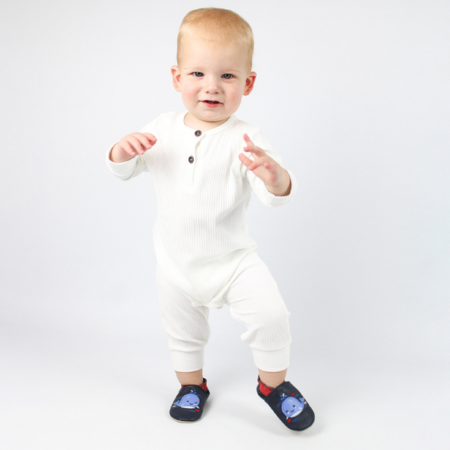
It's important to remember that every baby develops at their own pace, and some babies may prefer to be barefoot for longer periods of time while others resist textures on their feet. Always prioritise your baby's comfort, safety, and natural foot development when choosing pre-walkers or first walking shoes. Fashion and style should never be substituted for foot health and comfort. Consult with your health visitor, paediatrician or other qualified healthcare professional to provide further guidance based on your baby's individual needs and development. If you are worried about your babies foot development then ask for advice.
Happy Toddling,
The Dotty Fish Team

